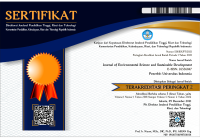Abstract
In recent decades, water resources shrink at an alarming rate in some areas both nationally and internationally. Water resources are directly proportional to the growth in human population. The higher demand for settlement and agriculture are considered to be important factors responsible for the degradation in water quality and resource functions. The aim of this study was to analyze the diversity of vegetation in the water resources area, as well as the level of human participation in the conservation efforts. The study was conducted using a mixed method based on observation and interviews of the local community. The plant diversity in the study area, Dandang water resource, consisted of medium category tree habitus (h'= 1.42); bush habitus (h'= 1.61); and herb habitus (h'= 2.29), there are 27 species from 15 families comprising 9 trees, 6 bushes, and 12 herbs. The level of human participation is still at the whim with limited operational support strength (0.80%). The social capital including communications between parties and organizing resources is a sufficient advantage (58%). However, the involvement of community and village governments in the conservation efforts is still weak (38%). The situation is aggravated by the lack of policies and regulations implemented by the village government (38%). Policy interventions and regulations are important, along with socialization and mentoring programs for the conservation of Dandang water resource area.
Recommended Citation
Karuniasa, Mahawan and Prambudi, Priyaji Agung
(2019).
TRANSITION OF PRIMARY FOREST TO SECONDARY FOREST AND THE IMPACT FOR WATER RESOURCES CONSERVATION.
Journal of Environmental Science and Sustainable Development, 2(1), 15-25.
Available at: https://doi.org/10.7454/jessd.v2i1.34








